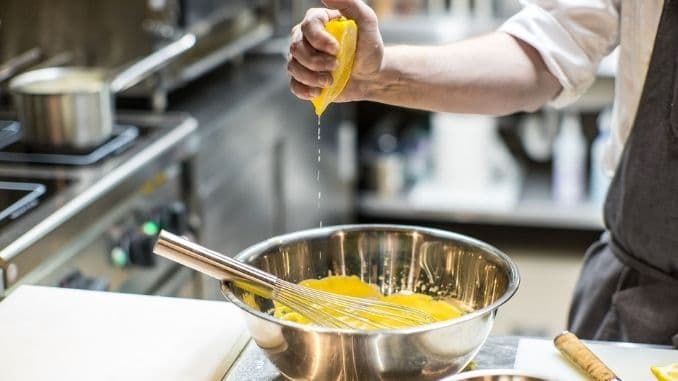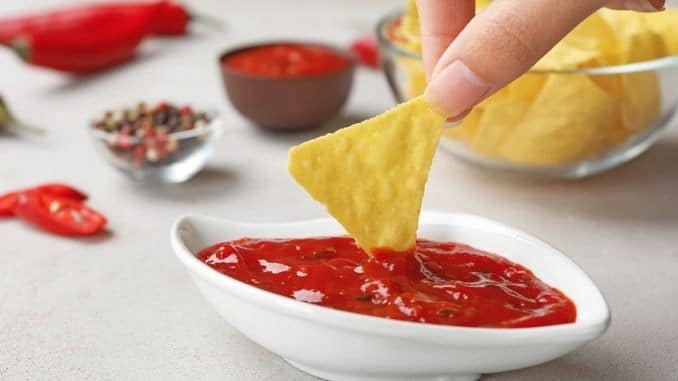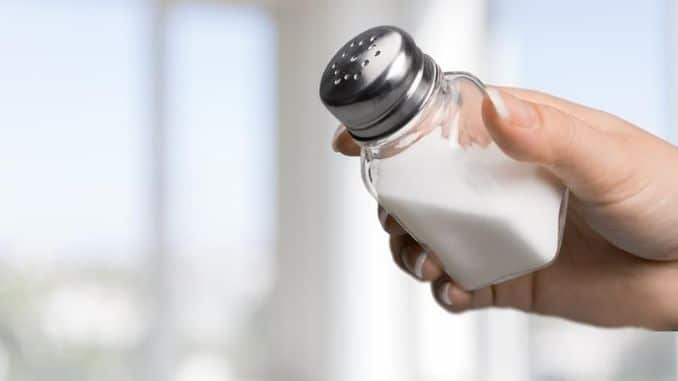
Eating less salt can be challenging. Salt seems to be in nearly every food we eat. While we know that the human body needs around 500 milligrams of dietary sodium each day for proper functioning, nearly all of us consume much more than that.
According to a 2014 worldwide study published in the New England Journal of Medicine, on average, adults consume a whopping 3,950 milligrams of sodium each day ― around eight times the amount we need. This average consumption is also nearly three times the 1,500-milligrams-per-day limit suggested by the American Heart Association (AHA).

Reasons to Use Less Salt
Why use less salt? Many of us have ideal blood pressure readings and think that we don’t need to consider our sodium intake. After all, if there was a problem, wouldn’t it show up during my physical?
The answer is complicated. As we’ve established, most people get way too much sodium in their diets each day. While it may not be affecting certain individuals currently, a high sodium diet can lead to high blood pressure, kidney problems, dehydration, electrolyte imbalances, gastric ulcers and respiratory complications in time.
According to the AHA, “When there’s extra sodium in your bloodstream, it pulls water into your blood vessels, increasing the total amount (volume) of blood inside them. With more blood flowing through your blood vessels, blood pressure increases. It’s like turning up the water supply to a garden hose.”
An increase in your blood pressure is not easy to notice. High blood pressure is often called a silent killer. Many people walk around with elevated blood pressure and have no symptoms of it at all, making them at risk for a sudden heart attack.
There are simple ways to use less salt. With salt being such an ample and integral part of our normal daily diets, it can seem incredibly difficult to cut back. Using less salt requires an intentional effort, but it can be done easily. We want you to stay on top of your health, so we’re suggesting these 15 simple ways to help you use less salt.
1. Know What You’re Seeking
Wouldn’t it be nice if packaged foods were labeled with bright red stickers that said, “Too much salt,” or “Way too much salt.” However, the salt often lies hidden in a product’s ingredient list. According to the AHA, there are at least 20 sneaky names for ingredients that add sodium to foods. Here is a list of other names that should be on your radar when you’re looking for added salt:
Other Common Names for Sodium
| Disodium guanylate (GMP) | Disodium inosinate (IMP) | Fleur de sel | Himalayan pink salt |
| Kosher salt | Monosodium glutamate (MSG) | Rock salt | Sea salt |
| Sodium bicarbonate | Sodium nitrate | Sodium citrate | Sodium chloride |
| Sodium erythorbate | Sodium glutamate | Sodium lactate | Sodium lauryl sulfate |
| Sodium metabisulfite | Sodium phosphate | Sodium diacetate | Trisodium phosphate |
2. Buy or Make Unsalted Nut Butter
Truly, it doesn’t take very long at all to adjust your taste buds to simple, unsalted peanut butter, almond butter or any other nut or seed spread. Look for natural varieties that contain just the nuts or seeds. You can also make your own nut butter with unsalted almonds, peanuts, cashews or sunflower seeds and a food processor. You can shave off up to 200 milligrams of sodium per serving with unsalted nut butter.
3. Use a Salt-free Seasoning Blend
I love salt-free seasoning blends. I have one that I use in everything from scrambled eggs to roasted root vegetables. It’s full of fantastic dried seasonings like onion, garlic, white pepper, rosemary, cumin, tomato granules, orange peel, and parsley. It imparts a ton of deep flavors into anything I’m cooking without even 1 milligram of sodium.
You can usually find these salt-free seasoning blends at spice stores and in the spice aisle of your local grocery store. Look for natural versions that contain only the dried spices without cornstarch, silicone or other anticaking agents. You can also make your blend from spices and dried herbs that you have in your cupboard or spice rack.

4. Squeeze a Lemon
Another wonderful low-salt cooking tip is to use lemon juice for flavor and acidity. Often, we might think a dish needs more salt when it may only need a bit of acid. Try a squeeze of lemon juice before you add salt and see how you like the taste.
5. Buy Frozen Instead of Canned Vegetables
Of course, fresh produce is best. But we all know that in some parts of the world, it just isn’t possible to use fresh, in-season produce all year long. However, canned produce is almost always loaded with extra salt and other additives.
Cruise to the frozen foods aisle when you’re shopping for out-of-season vegetables. You’ll still need to read the labels. However, you’ll find that most bags of frozen vegetables contain just the vegetables, with no added salt.
6. Order With Care at Restaurants
One of the biggest sources of sodium for many people is food from restaurants. Our friends over at the site, EatThisNotThat.com, reported that a large order of Blazin’ Buffalo Wings from the well-known chain, Buffalo Wild Wings, contains 9,490 milligrams of sodium. That’s one meal for some people.
Most restaurants have one goal: to make you love the taste of their food. One of the simplest ways to accomplish that goal is to load up the food with salt, sugar, and fat.
When you must eat out, request that your food be made without extra salt. Order simple items like grilled vegetables and a serving of protein. Choose items that are less likely to have several thousand milligrams of sodium.

7. Eat at Home More Often
It’s difficult to maintain a low-sodium diet when you’re eating out. Choose to prepare your foods at home more often instead. You’ll have all of the control over what goes into your food when you’re the head chef.
8. When You’re Baking, Use Half the Salt
In recipes, you can almost always get away with using just half of the recommended amount of salt, or less. Get into the habit of cutting the salt by half automatically when you’re baking anything. Once you get comfortable with that, experiment with omitting the salt entirely in your baked goods.
9. Watch Your Snacks
Many of the snacks that we might even consider healthy are extra high in sodium. Salted nuts, pretzels, string cheese, chips, and jerky are all snacks that are loaded with added sodium.
Replace salty snacks with healthier foods like cucumber slices, carrot sticks with hummus, boiled eggs, apple slices, fresh berries, unsalted almonds, and orange slices. Seek out whole, unprocessed foods in place of high salt, processed snacks.
10. Beware of Frozen Entrees
Yes, the frozen lasagna that tastes so good do so because it likely contains nearly 2,000 milligrams of sodium per serving. Frozen entrees are often extremely high in sodium. If you’re trying to reduce your salt intake, eliminate frozen meals from your diet. Stick to homemade pizza, lasagna, and burritos over frozen ones.

11. Switch to Unsalted Tortilla Chips
I’m a chips and salsa fan. However, when my husband’s blood pressure got a little too high for comfort, we decided to buy foods with lower sodium. I didn’t think that I would like unsalted tortilla chips, but I was wrong. The first time I tried them with my favorite salsa, they were excellent. I was surprised at how I didn’t miss the salt at all.
12. Look for Unsalted Marinara Sauce
When you’re shopping for pasta sauce, check the natural and organic brands for a no-salt-added sauce. It’s generally bursting with bold and bright tomato flavors. You won’t even miss the sodium.
13. Use Vinegar and Oil Salad Dressing
Salad is wonderful to eat each day, but often the dressing is full of salt. Save yourself up to 500 milligrams of salt per salad by using a simple vinegar and oil dressing with some fresh herbs instead of bottled salad dressing.
14. Cook With Fresh Herbs
It’s amazing how little added salt you need when you’re cooking with fresh herbs. Rosemary, parsley, basil, and chives can do so much for your home-cooked meals. Consider chopping up some fresh herbs and storing them in the freezer so that you can use them any time you’re cooking.

15. Take the Salt Shaker Off the Table
Sometimes, we get into habits that aren’t the best for us. Salting our food before we begin to eat can be a habit. If you store your salt shaker in the pantry or the spice drawer, instead of on the dining table, it takes more effort to add salt to your dish. Chances are, if you have to walk across the kitchen to find the salt, you’ll decide that your food tastes fine as it is and skips it.
Use Less Salt
Cutting back on salt isn’t as difficult as you may have thought. It takes a little dedicated effort, some label reading, and a few slight changes to lower your sodium consumption substantially. Employ these 15 tips to use less salt every day.
For foods that help you slim down and get healthy, make sure to check out The Best Foods that Rapidly Slim & Heal in 7 Days.
.

